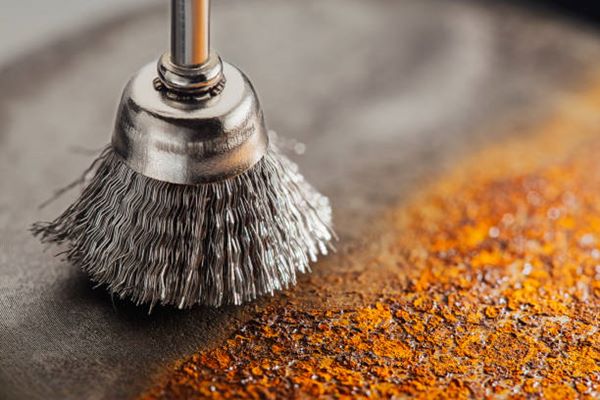Rust, the silent adversary of metal surfaces, has plagued industries and individuals for centuries. As technology advances, so do the methods to combat this corrosive menace. Laser rust removal has emerged as a promising alternative to traditional methods. This article aims to conduct a comprehensive comparative analysis of laser rust removal versus traditional methods. We will delve into their processes, effectiveness, and applications.
Understanding Rust and Its Consequences
Rust, scientifically known as iron oxide, occurs when iron or metal alloys react with oxygen and moisture. The consequences of rust extend beyond mere aesthetics. It compromises structural integrity, leading to safety hazards and financial losses. Traditional methods of rust removal, such as sandblasting, grinding, and chemical treatments, have been the go-to solutions for decades. However, the advent of laser technology introduces a new player in the field.
The Mechanics of Traditional Rust Removal
1: Sandblasting
Sandblasting involves propelling abrasive materials, such as sand or grit, at high speeds onto the rusted surface. This abrasive action physically removes the rust, leaving behind a clean metal surface. While effective, sandblasting can be harsh, potentially causing damage to the substrate and necessitating careful handling.
2: Grinding
Grinding, a mechanical method, employs abrasive wheels or discs to scrape away rust. It is a versatile method suitable for various surfaces but requires skilled operators to prevent over-removal or surface damage. The process generates dust and noise, posing environmental and health concerns.
.3: Chemical Treatments
Chemical rust removers involve applying corrosive substances that dissolve or convert rust into a soluble form. Although effective, these chemicals often contain hazardous components, necessitating careful handling, and their disposal raises environmental concerns.
Laser Rust Removal – A High-Tech Contender
1: The Laser Rust Removal Process
Laser rust removal utilizes high-intensity laser beams to interact with rust particles, breaking them into fine dust that can be easily wiped away. This method offers precision and control, minimizing damage to the underlying substrate. The process is non-abrasive, making it suitable for delicate surfaces.
2: Precision and Selectivity
One of the primary advantages of laser rust removal is its precision. The laser can be precisely tuned to target rust while leaving the unaffected metal intact. This level of selectivity is especially crucial for intricate structures or surfaces with varying material compositions.
3: Minimal Environmental Impact
Laser rust removal is environmentally friendly, unlike traditional methods. It often involves abrasive materials or harsh chemicals. It produces minimal waste and the absence of chemicals. It reduces the risk of environmental contamination.
To delve deeper into the world of rust removal and explore cutting-edge solutions, learn more about the advanced technologies and products available. Click here to check a machine. Look for details on the advanced technologies they use and any innovative products they have developed for rust removal.
Comparative Analysis
1: Efficiency and Speed
Traditional methods like sandblasting and grinding are effective in rust removal but can be time-consuming, especially for large or intricate surfaces. Laser rust removal, on the other hand, is known for its speed and efficiency. The focused laser beams can cover large areas quickly. It can reduce downtime and increase productivity.
2: Surface Damage and Substrate Preservation
One common drawback of traditional methods is the potential for surface damage. Sandblasting and grinding can remove rust and a substrate layer, compromising the material’s integrity. Laser rust removal is a non-contact method. It can minimize the risk of substrate damage, making it suitable for delicate or valuable surfaces.
3: Safety Considerations
Traditional rust removal methods often involve using abrasive materials and chemicals. It poses safety risks to operators and the environment. Sandblasting generates airborne particles that can be harmful if inhaled. Chemical treatments need careful handling. Laser rust removal mitigates these risks, providing a safer working environment.
Applications of Laser Rust Removal
The precision and versatility of laser rust removal make it suitable for various applications.
1: Automotive Industry
In the automotive industry, laser rust removal proves invaluable for restoring vintage cars or treating rust-prone areas without compromising the vehicle’s structural integrity.
2: Aerospace Sector
Aerospace components often require intricate rust removal to maintain their functionality. Laser technology offers a controlled and efficient solution for such critical applications.
3: Art Restoration
The art world benefits from laser rust removal’s ability to delicately restore metal sculptures and artifacts without causing damage to the artistic elements.
Conclusion
In the ongoing battle against rust, the choice between laser rust removal and traditional methods depends on the specific requirements of the task at hand. Despite their efficacy, traditional methods like sandblasting and grinding come with drawbacks. Such as potential substrate damage and environmental concerns. With its precision, speed, and minimal ecological impact, laser rust removal emerges as a high-tech contender. It offers a safer and more efficient solution.





